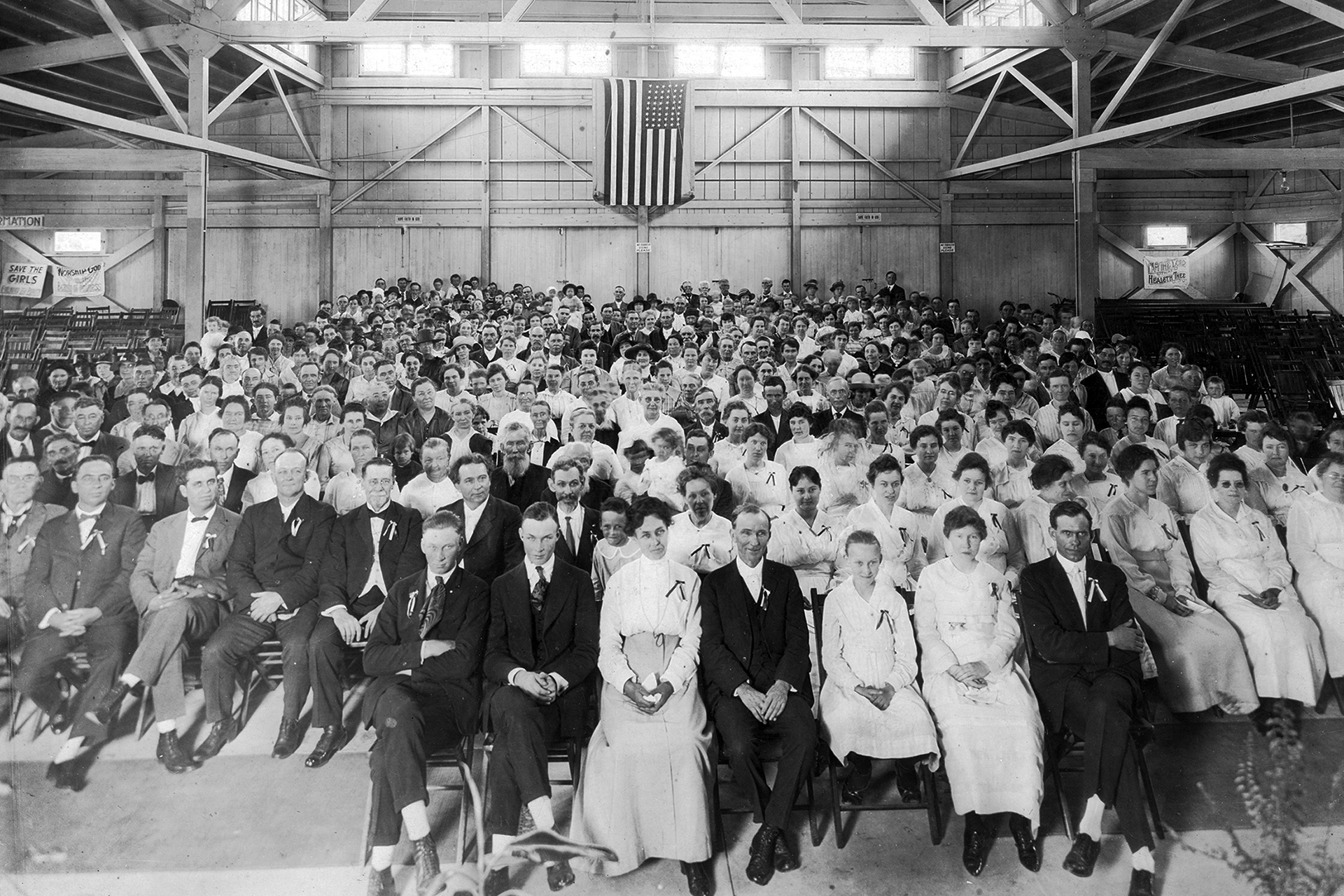
The Berachah Home Part 2 of 3: Religion
Although historians are trained to approach each topic without prejudice or pre-conceptions, I must admit when I first read the Berachah Cemetery historical marker located at Doug Russell Park, my thoughts went to Nathaniel Hawthorne’s The Scarlet Letter. I imagined a place where religion was used as a weapon against women, focused on harsh punishment as a means to redeem “fallen girls.” However, as I researched the home’s history, I found a somewhat different story.
I discovered that the Berachah Industrial Home for the Redemption of Erring Girls was one of an estimated 200 homes across the U.S. inspired by a national evangelical movement dedicated to improving the lives of young women in need. In a nutshell, the migration from rural to urban areas during the Industrial Revolution created an unexpected consequence: young women expecting to benefit financially by relocating to cities found themselves in an over-populated job market. Many turned to prostitution as a means to survive and opiates as a means to cope. Law enforcement did little to help the situation. The Protestant religious community responded by sending an army of rescue workers into the city slums to lead women to Christ. While their methods may today seem harsh, the history indicates that the evangelical movement was a sincere effort to right a social wrong.
Reverend James Tony Upchurch (1870-1950) and Maggie Mae Adams (1873-1963), founders of the Berachah Home, were dedicated proponents of this movement. Their story is preserved in the Berachah Home archives held at both the University of Texas at Arlington Library and the Church of the Nazarene Headquarters in Lenexa, Kansas. These archives consist of ledgers used for record keeping, correspondence, financial records, and monthly publications that provide insight into Reverend Upchurch’s religious philosophy by publicizing news of the movement and its good works, information on upcoming revivals and rescue workers’ conventions, or God’s progress with the Berachah Home.
These publications went by various names, such as the Purity Journal, the Purity Crusader, and the King Crusader. In their pages, Reverend Upchurch also provided his own testimony. He explained that he felt an innate sense of kindness toward people in need. Although Upchurch admitted that he did not find God or religion until he was 20 years old, in that moment serving God became his life. He credited God for filling him with the Holy Spirit and priming him for his rescue work.
During the first five years after his conversion, Upchurch developed his religious philosophy within the Methodist Church. He studied the Bible with his mentors and gained valuable experience as he served first in the prison ministry, then as a rescue worker in the slums of Waco, Texas. It was during his rescue work that Upchurch met and married Maggie Mae Adams. According to the sermon he delivered at the May 14, 1903 dedication service of the Berachah Home, he and Maggie answered God’s call in 1895. Together they embarked on a journey to follow God’s will through work in the evangelical movement. Under guidance from God, they began to make plans for the home, hoping to sway the public’s opinion of fallen girls. The home served as an example of God’s grace and strived to restore the lives of countless girls until it closed in 1935.
J. T. and Maggie Upchurch ran the home based on their interpretation of the evangelical movement and their own Christian faith. The home’s publications show that they fought battles on many fronts, seeking to end white slavery, outlaw abortion and contraception, raise the age of consent for females from 15 to 21, and remove the word “illegitimate” from the birth certificates of children born out of wedlock. Reverend Upchurch also kept his readers informed about the movement’s ideology, especially its emphasis on God’s ability to change lives and on the concept of “singular purity.”
Reverend Upchurch particularly stressed God’s ability to change lives. He often lamented society’s prevailing notion that a fallen girl could not be redeemed, using his monthly publication to provide dramatic examples of success stories, presented as undeniable truths. For example, in the 1905 April edition of the Purity Journal, Upchurch told the story of a young girl in Fort Worth who was saved from her death bed by conversion to Christianity. Her body was completely healed, she was blessed, and she went on to lead a Christian life.
Upchurch also stressed the importance of “singular purity,” the idea that young men should be held to the same purity standard as young women, with abstinence considered an essential trait for both genders. Throughout his publications, Upchurch and his staff seem perplexed as to why this double standard was so prevalent in the American social fabric. To them it was simple: a strict Christian upbringing identical for both boys and girls.
However, the evangelical movement was not Reverend Upchurch’s sole source of inspiration. Although Upchurch started his ministry with the Methodist Church, somewhere along the way he became involved with the more charismatic denominations and by 1908 became one of the founding members of the Church of the Nazarene. This denomination was formed when the Holy Church of Christ of Texas and the Pentecostal Church of the Nazarene united. While this new church was generally in step with the evangelical movement, they also developed their own theology. In addition to the evangelical emphasis on becoming saved, the Nazarenes greatly valued “sanctification”: the development of a deep personal relationship with God in which certain acts of goodness yield the ability not to sin. Reverend Upchurch expected salvation and sanctification for all the Berachah Home residents, which he believed would lead to the public’s acceptance of the girls in his care.
In 1921, E. M. Dealy, a reporter for the Dallas News, visited the Berachah Home. Not surprisingly, Dealy found it to be a deeply spiritual organization, but he also stressed its uniqueness compared to other homes of the time. For example, most homes required the mother and child to remain together for no more than 6 months before the child was put up for adoption. In sharp contrast, Upchurch strongly believed that mother and baby should remain together for at least one year, and the young women had to sign a contract agreeing to this stipulation before being accepted into the home.
Moreover, the time the young mother spent with her child was not viewed as punishment, but as fulfillment of a religious duty on the road to sanctification. In the January 21, 1981 issue of the Arlington Citizen Journal, Upchurch’s daughter Allie Mae Wiese (also Allie Mae Gilmore) explained her father’s rationale for keeping mother and baby together as related to the biblical story of Moses. When Moses’ mother placed him in a basket, then the river, to be rescued by the Pharaoh’s daughter, God saw to it that Moses was returned to his mother until he was weaned.
Other Church of the Nazarene beliefs also helped shape Reverend Upchurch’s approach to caring for women in need. For example, The Manual of the Church of the Nazarene, written in 1898, established the right of women to serve the church in every aspect, including as ministers (a concept still debated in some Protestant denominations). Even before women were allowed to vote, the Church of the Nazarene saw them as equals. These progressive notions about women were apparent at the Berachah Home. While other homes had religious training, it was not as in depth as what Reverend Upchurch offered. Entries in the Purity Journal describe the additional training provided to the girls who demonstrated an interest in Biblical study. Maggie Upchurch would take certain girls to the slums of Dallas to minister to the women of the streets, and the Berachah Home also produced several missionaries.
Upchurch also applied his progressive philosophy about women’s roles to education and vocational training. My research reveals that the girls in other homes were taught little more than basic domestic skills. However, the Berachah Home integrated the advice of women’s rights activist Ada C. Sweet (1853-1928), who argued all women in America should have the ability to support themselves. The home helped the girls learn how to take care of themselves and their babies, and they received a secular education in addition to their Bible studies. Girls who excelled in vocabulary and grammar were offered positions in the home’s print shop, while others learned how to farm or care for the children. Additionally, the girls could learn “industrial” skills at the handkerchief factory or laundry.
Throughout his life Reverend Upchurch maintained that he was chosen by God to change the public’s perception of “fallen girls” and put an end to the prejudices that followed them. From 1903 to 1935, the Berachah Home provided a place for him to put his calling into practice. Upchurch’s methods may not have been perfect, but his efforts were to help desperate girls were sincere.
Read part 3 of this article.

